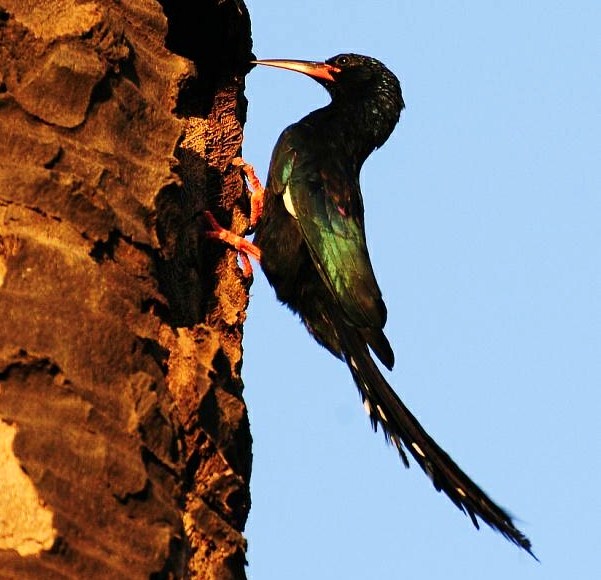Phoeniculus purpureus
 |
| (Photo from Internet Bird Collection) |
Common name:
green woodhoopoe (en); zombeteiro-de-bico-vermelho (pt); irrisor moqueu (fr); abubilla-arbórea verde (es); baumhopf (de)
Taxonomy:
Order Coraciiformes
Family Phoeniculidae
Range:
This species is found throughout most of sub-Saharan Africa, with the exception of the lowland forest of the D.R. Congo and West Africa.
Size:
The green woodhoopoe is 37-44 cm long and weighs up to 100 g.
Habitat:
This species generally prefers arid and mesic savannas, open miombo woodlands, palm groves, riverine forests, forest fringes, valley bushveld, thickets and wooded gardens. They are found from near sea level to altitudes of over 2.000 m.
Diet:
The green woodhoopoe mainly eats arthropods, foraging mainly on tree trunks and branches, probing and searching for food and occasionally descending to the ground. They are known to take Coleoptera, Lepidoptera, Hymenoptera, Hemiptera, Orthoptera, Neuroptera, Odonata, Aranea, Sulifugae and Chilopoda. They may ocasionally also take small reptiles and amphibians, plant seeds, nectar, berries and fruits.
Breeding:
These birds can breed all year round. They are monogamous, cooperative breeders, meaning that the breeding pair is assisted by non-breeding helpers. They nest in pre-existing cavities such as hollows in trees, fence posts or buildings. The female lays 2-5 blue eggs which she incubates alone for 17-18 days, while being provided food by the male and group members. The chicks are mostly fed by the female, but the food is gathered by the male and a number of helpers. The chicks fledge 28-30 days after hatching, but continue to receive food from their parents for another 2-3 months.
Conservation:
IUCN status – LC (Least Concern)
The green woodhoopoe has an extremely large breeding range and is reported to be extremely widespread and often common to locally common. The population is declining locally owing to ongoing habitat destruction.







